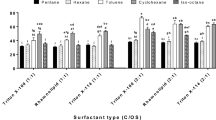Abstract
Oily sludge is a stable emulsion of water in oil, containing solid particles, oily hydrocarbons, and metals with different compositions, which is greatly hazardous to the environment; as a consequence, they must be removed or recovered. Recovery methods are usually preferable because of the possibility of valuable oily hydrocarbons recovery as well as environmental protection. Liquid extraction is one of the most effective methods of oily sludge recovery. In this research, hydrocarbon recoveries from oily sludge using liquid extraction with methyl ethyl ketone (MEK) and toluene as polar and non-polar solvents have been studied and compared to each other. Different parameters will affect the quality of extraction process, among which the temperature, time, and solvent to sludge ratio are the most important ones. Response surface methodology was used as a method of experimental design to find the optimum conditions for obtaining maximum recovery. Then, the sludge recovery efficiencies under the optimum conditions for MEK and toluene were determined by gas chromatography and compared to each other. The results showed 30.41 and 37.24% hydrocarbon recovery for MEK and toluene respectively. Since the major composition of the sludge consisted of non-polar components, therefore, non-polar solvent (MEK) shows better efficiency. The optimum conditions of the studies were 20 °C, 19 min, and 6.4/4.2 for MEK and 55 °C, 17 min, and 3.6/3.6 for toluene.




Similar content being viewed by others
References
Abouelnasr, D., and Al Zubaidy, E. A. (2008). Treatment and recovery of oil-based sludge using solvent extraction. Paper presented at the Abu Dhabi International Petroleum Exhibition and Conference.
Al-Zahrani, S. M., & Putra, M. D. (2013). Used lubricating oil regeneration by various solvent extraction techniques. Journal of Industrial and Engineering Chemistry, 19(2), 536–539.
Bezerra, M. A., Santelli, R. E., Oliveira, E. P., Villar, L. S., & Escaleira, L. A. (2008). Response surface methodology (RSM) as a tool for optimization in analytical chemistry. Talanta, 76(5), 965–977.
Box, G. E. & Draper, N. R. (1987). Least squares for response surface work. Response Surfaces, Mixtures, and Ridge Analyses, Second Edition, 29-91.
Cambiella, A., Benito, J., Pazos, C., & Coca, J. (2006). Centrifugal separation efficiency in the treatment of waste emulsified oils. Chemical Engineering Research and Design, 84(1), 69–76.
Cheng, S., Wang, Y., Gao, N., Takahashi, F., Li, A., & Yoshikawa, K. (2016). Pyrolysis of oil sludge with oil sludge ash additive employing a stirred tank reactor. Journal of Analytical and Applied Pyrolysis, 120, 511–520.
Da Rocha, O. R. S., Dantas, R. F., Duarte, M. M. M. B., Duarte, M. M. L., & Da Silva, V. L. (2010). Oil sludge treatment by photocatalysis applying black and white light. Chemical Engineering Journal, 157(1), 80–85.
Elektorowicz, M., & Habibi, S. (2005). Sustainable waste management: recovery of fuels from petroleum sludge. Canadian Journal of Civil Engineering, 32(1), 164–169.
Fan, T., Wang, J., and Buckley, J. S. (2002). Evaluating crude oils by SARA analysis. Paper presented at the SPE/DOE Improved Oil Recovery Symposium.
Hall, D. W., Sandrin, J. A., & McBride, R. E. (1990). An overview of solvent extraction treatment technologies. Environmental Progress & Sustainable Energy, 9(2), 98–105.
Hu, G., Li, J., & Hou, H. (2015). A combination of solvent extraction and freeze thaw for oil recovery from petroleum refinery wastewater treatment pond sludge. Journal of Hazardous Materials, 283, 832–840.
Jean, D., Chu, C., & Lee, D. (2001). Freeze/thaw treatment of oily sludge from petroleum refinery plant. Separation Science and Technology, 36(12), 2733–2746.
Jin, Y., Zheng, X., Chu, X., Chi, Y., Yan, J., & Cen, K. (2012). Oil recovery from oil sludge through combined ultrasound and thermochemical cleaning treatment. Industrial & Engineering Chemistry Research, 51(27), 9213–9217.
Mao, X., Jiang, R., Xiao, W., & Yu, J. (2015). Use of surfactants for the remediation of contaminated soils: a review. Journal of Hazardous Materials, 285, 419–435.
Myers, R. H., Montgomery, D. C., and Anderson-Cook, C. M. (2016). Response surface methodology: process and product optimization using designed experiments: John Wiley & Sons.
Qin, L., Han, J., He, X., Zhan, Y., & Yu, F. (2015). Recovery of energy and iron from oily sludge pyrolysis in a fluidized bed reactor. Journal of Environmental Management, 154, 177–182.
Ramaswamy, B., Kar, D., & De, S. (2007). A study on recovery of oil from sludge containing oil using froth flotation. Journal of Environmental Management, 85(1), 150–154.
Shie, J. L., Chang, C. Y., Lin, J. P., Wu, C. H., & Lee, D. J. (2000). Resources recovery of oil sludge by pyrolysis: kinetics study. Journal of Chemical Technology and Biotechnology, 75(6), 443–450.
da Silva, L. J., Alves, F. C., & de França, F. P. (2012). A review of the technological solutions for the treatment of oily sludges from petroleum refineries. Waste Management & Research, 30(10), 1016–1030.
Taiwo, E., & Otolorin, J. (2009). Oil recovery from petroleum sludge by solvent extraction. Petroleum Science and Technology, 27(8), 836–844.
Wang, Y., Zhang, X., Pan, Y., and Chen, Y. (2017). Analysis of oil content in drying petroleum sludge of tank bottom. International Journal of Hydrogen Energy.
Xu, N., Wang, W., Han, P., & Lu, X. (2009). Effects of ultrasound on oily sludge deoiling. Journal of Hazardous Materials, 171(1), 914–917.
Zubaidy, E. A., & Abouelnasr, D. M. (2010). Fuel recovery from waste oily sludge using solvent extraction. Process Safety and Environmental Protection, 88(5), 318–326.
Author information
Authors and Affiliations
Corresponding author
Rights and permissions
About this article
Cite this article
Nezhdbahadori, F., Abdoli, M.A., Baghdadi, M. et al. A comparative study on the efficiency of polar and non-polar solvents in oil sludge recovery using solvent extraction. Environ Monit Assess 190, 389 (2018). https://doi.org/10.1007/s10661-018-6748-6
Received:
Accepted:
Published:
DOI: https://doi.org/10.1007/s10661-018-6748-6




